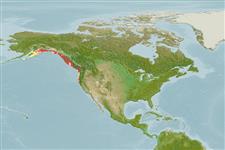Mesocentrotus franciscanus (Agassiz, 1863)
Red Sea urchin| Native range | All suitable habitat | Point map | Year 2050 |

|
| This map was computer-generated and has not yet been reviewed. |
| Mesocentrotus franciscanus AquaMaps Data sources: GBIF OBIS |
Upload your photos
Google image |
No photo available for this species.No drawings available for Strongylocentrotidae.
Google image |
No photo available for this species.
Classification / Names Common names | Synonyms | CoL | ITIS | WoRMS
Echinoidea | Camarodonta | Strongylocentrotidae
Environment: milieu / climate zone / depth range / distribution range Ecology
Benthic; depth range 0 - 125 m (Ref. 95072). Temperate; 71°N - 32°N, 141°E - 117°W
Distribution Countries | FAO areas | Ecosystems | Occurrences | Introductions
Arctic and Northern Pacific.
Length at first maturity / Size / Weight / Age
Maturity: Lm ?, range 4 - 5 cm Max length : 19.0 cm WD male/unsexed; (Ref. 128652); max. reported age: 200 years (Ref. 128652)
Harvestable size is around 9-10 cm test diameter (4-5 years in age) (Ref. 121955). Found in relatively high energy environments on open rocky intertidal and subtidal shores (Ref. 121802). Herbivorous grazer in nearshore habitats (Ref. 121801). Kelp forest species (Ref. 121804). Found in concentrated amount at the apex of the holdfast of the giant kelp Macrocystis pyrifera (Ref. 121803).
Life cycle and mating behavior Maturity | Reproduction | Spawning | Eggs | Fecundity | Larvae
Members of the class Echinoidea are gonochoric. Fertilization is external. Brooding is common, eggs are held either on the peristome, around the periproct or deep into the concavities on the petaloids. Life cycle: Embryos develop into planktotrophic larvae (echinoplateus) and live for several months before they sink to the bottom using their tube feet to adhere on the ground where they metamorphose into young urchins.
Main reference
References | Coordinator | Collaborators
Bisby, F.A., M.A. Ruggiero, K.L. Wilson, M. Cachuela-Palacio, S.W. Kimani, Y.R. Roskov, A. Soulier-Perkins and J. van Hertum. 2005. (Ref. 19)
IUCN Red List Status (Ref. 130435)
CITES status (Ref. 108899)
Not Evaluated
CMS (Ref. 116361)
Not Evaluated
Threat to humans
Human uses
Fisheries: commercial
| FishSource |
Tools
More information
Internet sources
BHL | BOLD Systems | CISTI | DiscoverLife | FAO(Publication : search) | Fishipedia | GenBank (genome, nucleotide) | GloBI | Gomexsi | Google Books | Google Scholar | Google | PubMed | Tree of Life | Wikipedia (Go, Search) | Zoological Record
Estimates based on models
Preferred temperature
(Ref. 115969): 4.1 - 10.7, mean 8.6 (based on 90 cells).
Resilience
(Ref. 69278):
Low, minimum population doubling time 4.5 - 14 years (K=0.08).


